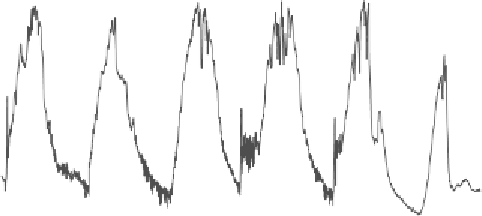Environmental Engineering Reference
In-Depth Information
(enthalpy of the supply air with isenthalpic dehumidification). Although both depend
on temperature and absolute humidity, the equations cannot be solved analytically and
the final state must be iterated. For this the absolute water vapour content of the supply
air
x
o
is reduced until the final state corresponds to the given humidity condition of
the regeneration air. The new temperature and relative humidity values are determined
after each dehumidifying step, until supply air humidity and regeneration humidity
correspond. Since the contact time of the air within the channels of the sorption rotor is
short and the sorption material is limited, the minimum value of the supply air humid-
ity with a vapour content
x
dry
ideal
is not achieved in practice. Non-ideal dehumidifying
at an effective supply air humidity value
x
dry
eff
is covered by the dehumidification
efficiency
η
dh
x
eff
x
o
−
dry
x
o
−
x
ideal
η
dh
=
dry
=
x
o
−
η
dh
x
o
−
x
ideal
x
eff
(5.4)
dry
dry
The best fit to the experimental data was obtained for a dehumidifcation efficiency
of 80%. Measured and simulated temperature levels after the sorption wheel (sup-
ply side) coincide very well, which shows the suitability of the simple model (see
Figure 5.39).
The component parameters from the experimental analysis of the two desiccant
cooling units in Spain and Germany are summarized in Table 5.3.
The system model includes the preheating of the regeneration air using the factory
waste heat. Mixing of the maximum collector volume flow of 6000m
3
h
−
1
and the
air, which is only preheated, takes place in the regeneration air stream before entering
the desiccant cooling unit.
60
Regeneration
55
50
45
SW out measured
40
35
SW out simulated
30
25
20
15
SW in
10
23
24
25
26
27
28
Date in July
Figure 5.39
Measured and simulated temperature levels after dehumidification by the sorption wheel
(SW) on the supply air side together with inlet and regeneration temperatures







Search WWH ::

Custom Search